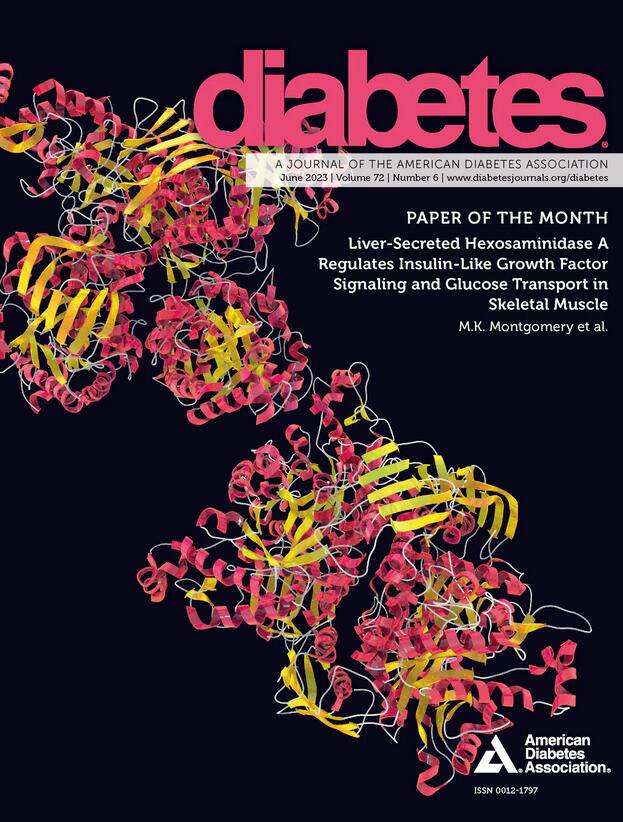778-P: Pemvidutide, a Balanced GLP-1/Glucagon Dual Receptor Agonist, Enhances Reverse Cholesterol Transport in a Golden Syrian Hamster Model
IF 7.5
1区 医学
Q1 ENDOCRINOLOGY & METABOLISM
引用次数: 0
Abstract
Introduction and Objective: Pemvidutide is a long-acting, peptide-based GLP-1/glucagon dual receptor agonist that elicits significant reductions in body weight and serum lipids in preclinical and clinical studies. Reverse cholesterol transport (RCT) is an important process for removing excess cholesterol from peripheral tissues. Preclinical studies have suggested that glucagon may enhance the elimination of cholesterol, possibly due to enhanced RCT. Here, we investigated the effects of pemvidutide on RCT via cholesterol excretion in a preclinical model. Methods: Obese male Golden Syrian hamsters were treated daily with pemvidutide or vehicle for 35 days. On Day 35, macrophages labelled with 3H-cholesterol were injected intraperitoneally, and the appearance of the 3H-cholesterol in plasma, liver, and feces was quantitated over 72 hours. In an independent study, changes in the hepatic expression of genes involved in cholesterol transport were measured by reverse transcription-polymerase chain reaction (RT-PCR) following pemvidutide treatment. Results: Pemvidutide treatment significantly reduced total plasma triglycerides, total cholesterol, and LDL-cholesterol as compared to vehicle controls. Specifically, pemvidutide significantly reduced plasma 3H-cholesterol and increased the excretion of 3H-cholesterol and its metabolites in feces over 72 hours. RT-PCR analysis showed significantly increased hepatic gene expression of the cholesterol transporters ABCG5 and ABCG8 in the pemvidutide treated group compared to vehicle. Conclusion: Pemvidutide treatment increased excretion of cholesterol into feces and upregulated transporters of cellular cholesterol in the liver, consistent with increased RCT. These findings suggest that in addition to other mechanisms, pemvidutide improves serum cholesterol through enhanced cholesterol excretion. Disclosure M. Lucca Andrade: Employee; Altimmune Inc. J.J. Suschak: Employee; Altimmune Inc. B. Georges: Employee; Altimmune Inc. F. Briand: Employee; PHYSIOGENEX. Stock/Shareholder; PHYSIOGENEX. M.S. Roberts: Employee; Altimmune Inc.778-P: Pemvidutide,一种平衡GLP-1/胰高血糖素双受体激动剂,在金色叙利亚仓鼠模型中增强逆向胆固醇转运
简介和目的:Pemvidutide是一种长效肽类GLP-1/胰高血糖素双受体激动剂,在临床前和临床研究中可显著降低体重和血脂。逆向胆固醇转运(RCT)是从外周组织中去除多余胆固醇的重要过程。临床前研究表明,胰高血糖素可能促进胆固醇的消除,可能是由于增强的随机对照试验。在这里,我们在临床前模型中通过胆固醇排泄研究了培维肽对RCT的影响。方法:肥胖雄性叙利亚金仓鼠每天给予培维肽或载药治疗,连续35 d。第35天,腹腔注射标记有3h -胆固醇的巨噬细胞,并在72小时内定量观察血浆、肝脏和粪便中3h -胆固醇的形态。在一项独立研究中,通过逆转录聚合酶链反应(RT-PCR)测量了培维肽治疗后肝脏中胆固醇转运相关基因表达的变化。结果:与对照相比,培维多肽治疗显著降低了血浆总甘油三酯、总胆固醇和低密度脂蛋白胆固醇。具体来说,培维肽显著降低血浆3h -胆固醇,并在72小时内增加粪便中3h -胆固醇及其代谢物的排泄。RT-PCR分析显示,与对照组相比,培维肽治疗组胆固醇转运体ABCG5和ABCG8的肝脏基因表达显著增加。结论:培维肽治疗增加了胆固醇排入粪便和上调肝脏细胞胆固醇转运蛋白,与增加的RCT一致。这些发现表明,除了其他机制外,培维肽还通过促进胆固醇排泄来改善血清胆固醇。M. Lucca Andrade:员工;Altimmune Inc .)J.J. Suschak:雇员;Altimmune Inc .)B. george:雇员;Altimmune Inc .)F. Briand:员工;PHYSIOGENEX。股票/股东;PHYSIOGENEX。罗伯茨:雇员;Altimmune Inc .)
本文章由计算机程序翻译,如有差异,请以英文原文为准。
求助全文
约1分钟内获得全文
求助全文
来源期刊

Diabetes
医学-内分泌学与代谢
CiteScore
12.50
自引率
2.60%
发文量
1968
审稿时长
1 months
期刊介绍:
Diabetes is a scientific journal that publishes original research exploring the physiological and pathophysiological aspects of diabetes mellitus. We encourage submissions of manuscripts pertaining to laboratory, animal, or human research, covering a wide range of topics. Our primary focus is on investigative reports investigating various aspects such as the development and progression of diabetes, along with its associated complications. We also welcome studies delving into normal and pathological pancreatic islet function and intermediary metabolism, as well as exploring the mechanisms of drug and hormone action from a pharmacological perspective. Additionally, we encourage submissions that delve into the biochemical and molecular aspects of both normal and abnormal biological processes.
However, it is important to note that we do not publish studies relating to diabetes education or the application of accepted therapeutic and diagnostic approaches to patients with diabetes mellitus. Our aim is to provide a platform for research that contributes to advancing our understanding of the underlying mechanisms and processes of diabetes.
 求助内容:
求助内容: 应助结果提醒方式:
应助结果提醒方式:


